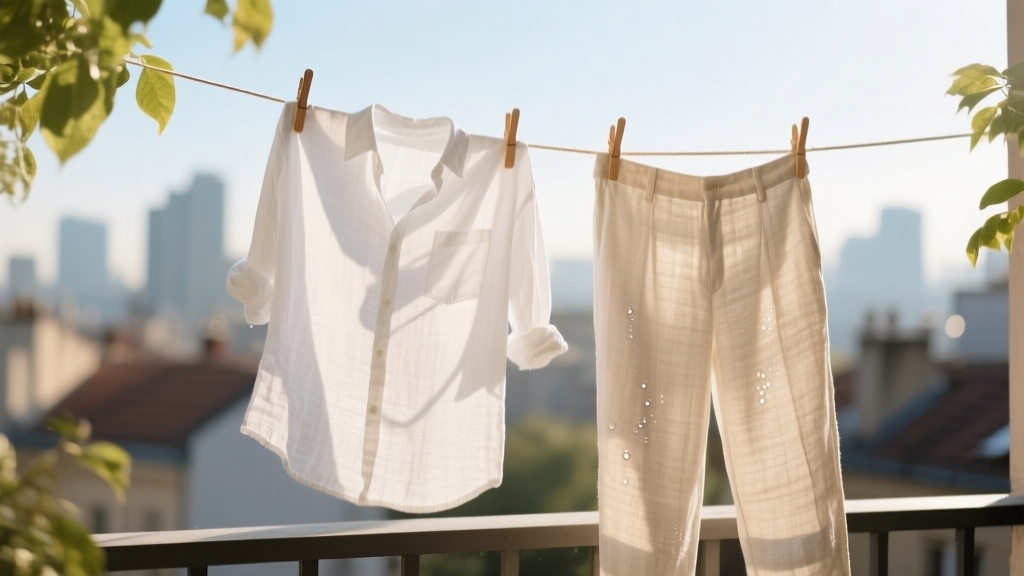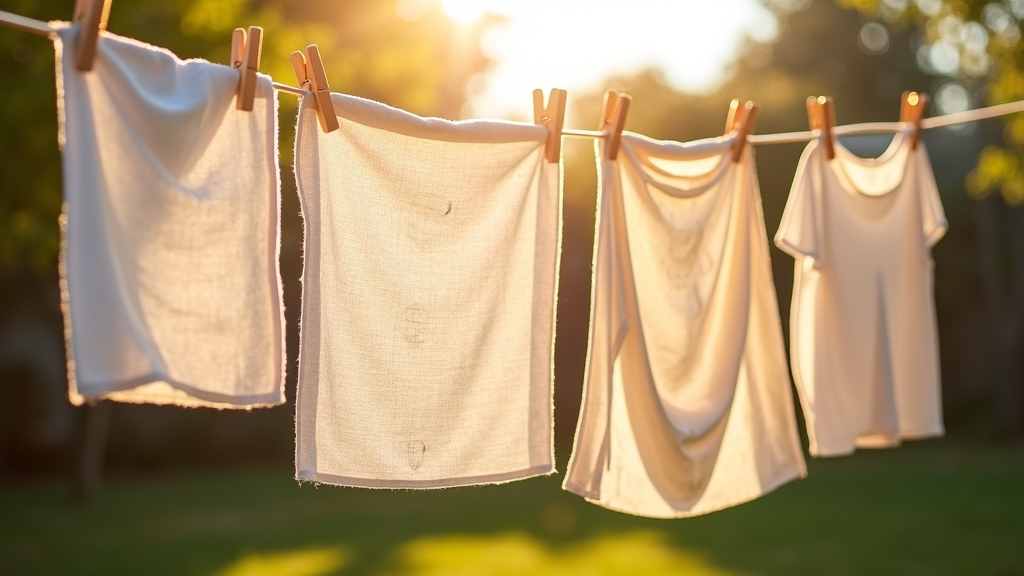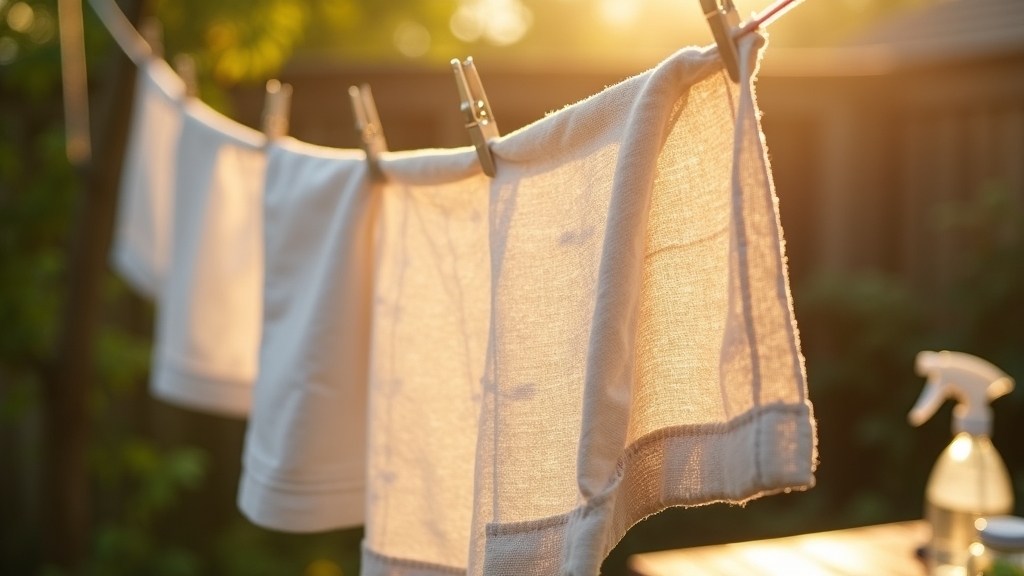
You’ll find linen dries quickly due to its loosely woven fibers that wick moisture efficiently through capillary action. Compared to denser fabrics like cotton, wool, or silk, linen’s structure and breathability promote faster evaporation, especially in low humidity and good airflow.
Heat speeds drying but may damage fibers, so balancing temperature and ventilation is key. Understanding these factors lets you optimize drying methods while preserving linen quality. Explore strategies to enhance both drying speed and fabric longevity.
Key Takeaways
- Linen dries faster than many natural fibers like cotton, wool, and silk due to its loosely woven fiber structure.
- Its fiber lumen and capillary action wick moisture efficiently, promoting quick evaporation and comfort.
- Breathability and moisture-wicking properties prevent dampness, enhancing drying speed and temperature regulation.
- Sunlight and good airflow significantly accelerate linen drying by increasing evaporation rates.
- Proper care, including low to medium heat drying and air drying in ventilated areas, preserves linen’s quick-dry qualities.
Linen Drying Speed Compared to Other Fabrics

Although synthetic fabrics like polyester dry faster due to their hydrophobic properties, linen offers a unique balance of natural absorbency and rapid moisture evaporation.
Linen uniquely balances natural absorbency with quick moisture evaporation for superior drying performance.
It outperforms many natural fibers such as cotton, wool, and silk. Linen’s fiber structure is loosely woven, facilitating quicker moisture diffusion and evaporation compared to cotton’s denser weave, which retains dampness longer. Using proper fabric care techniques can further enhance linen’s drying performance and longevity.
Unlike wool and silk, linen absorbs less water and exhibits superior breathability, speeding drying time. Its natural structure, including lumen and interfibrillar spaces, wick moisture via capillary action, aiding in temperature regulation and preventing clamminess.
While synthetics dry faster by repelling water, linen’s natural moisture-wicking prevents excessive dampness, enhancing comfort. Its drying efficiency maintains fabric integrity and freshness in warm conditions.
Therefore, linen’s combination of moderate absorbency and structural permeability allows it to dry faster than many natural alternatives, making it a technically superior fabric for rapid drying and user comfort. This characteristic contributes to linen’s popularity among travelers who appreciate durable and breathable textiles.
Environmental Conditions Influencing Linen Drying
Did you know that temperature and humidity play a huge role in how quickly linen dries? They really influence the drying rate and even the softness of the fibers. It all comes down to how moisture evaporates and how pectin behaves in the fabric.
Linen’s hygroscopic nature requires consistent airflow to prevent mildew and odors, highlighting the importance of balanced environmental conditions. Additionally, selecting eco-friendly fabrics like linen contributes to sustainable textile practices.
Now, let’s talk about sunlight. It can be a bit of a double-edged sword. On one hand, it helps speed up the drying process, but on the other hand, too much exposure can make the fibers stiff or even damage them over time. So, finding that perfect balance is key!
And don’t forget about airflow! Good airflow is essential for even drying, plus it helps keep any pesky microbes at bay. This way, you won’t have to worry about any lingering dampness or bad odors.
Temperature and Humidity
When drying linen, temperature and humidity play critical roles in determining both the drying time and fabric quality. Higher temperatures accelerate moisture evaporation but risk shrinkage and fiber damage if excessive. It is important to use low to medium heat settings to avoid excessive shrinkage and maintain the fabric’s integrity.
Conversely, low to medium heat preserves linen integrity but extends drying duration. Humidity inversely affects drying speed; high humidity retards evaporation, increasing drying time and mildew risk, while low humidity expedites drying. Taking preventive measures like avoiding rough handling and maintaining fabric condition can also help preserve linen quality during drying.
| Temperature Level | Effect on Drying Time | Impact on Fabric Quality | Humidity Level | Effect on Drying Time |
|---|---|---|---|---|
| High | Fast | Shrinkage, brittleness | High | Slow, mildew risk |
| Medium | Moderate | Maintains strength | Moderate | Moderate |
| Low | Slow | Preserves softness | Low | Fast |
Adjust temperature and humidity control to optimize drying efficiency and fabric longevity.
Sunlight Exposure Effects
Controlling temperature and humidity sets the stage for efficient linen drying, but sunlight exposure adds another dynamic layer to contemplate. Adjusting the drying environment can be as crucial as coordinating outfit colors for complementary balance.
Direct sunlight accelerates evaporation by delivering radiant heat, which raises the fabric temperature and enhances moisture release.
Linen’s breathable fibers absorb moisture quickly, so 2-3 hours of sun exposure markedly shortens drying time compared to shade.
However, UV-A and UV-B rays penetrate linen, providing germicidal benefits while gradually breaking down dyes and fiber bonds. Excessive exposure risks color fading and fiber weakening, reducing fabric integrity over time.
To maximize, balance sun duration; peak sunlight hours maximize drying efficiency, yet limiting exposure preserves linen strength and appearance.
You must weigh drying speed against potential UV-induced damage for ideal linen care outdoors. Additionally, line drying cuts energy costs and lowers carbon footprint, making sun drying an environmentally friendly and cost-effective alternative.
Airflow and Ventilation
Although temperature and sunlight considerably influence linen drying, airflow and ventilation play equally vital roles by regulating moisture removal from the fabric surface.
Increased airflow accelerates evaporation by continuously displacing water vapor around linen fibers, preventing moisture buildup and reducing mildew risk. This process helps avoid the formation of saturated boundary layers that can slow drying and cause uneven fiber stiffness.
Outdoor drying benefits from consistent wind speeds, producing faster, more uniform drying than stagnant indoor air. Many travelers use soft-sided duffel bags for their flexible packing benefits, which can also be influenced by environmental airflow during drying.
Indoors, mechanical ventilation mimics this effect but often lacks consistency, risking patchy drying and prolonged dampness.
Since linen absorbs up to 20% of its weight in water, managing airflow is essential to balance drying speed with fabric texture. Too rapid drying stiffens fibers, while slower drying preserves softness.
Controlling ambient humidity further optimizes drying, as high humidity impedes vapor removal. Therefore, effective ventilation directly impacts linen’s drying efficiency, texture, and longevity.
Air Drying Versus Machine Drying Linen
Because air drying depends heavily on environmental factors like temperature, humidity, and airflow, it generally takes longer to dry linen compared to machine drying, which uses heated air circulation to expedite the process consistently regardless of external conditions. Understanding the effects of moisture on fabric can help optimize drying methods.
When you air dry linen, the absence of heat and tumbling extends drying time, especially in cool or humid environments. Air drying is ideal for delicate, dark, or heat-sensitive fabrics, making it a gentle option for linen.
Conversely, machine drying accelerates moisture removal through controlled heat and mechanical action, ensuring rapid and uniform drying.
However, this convenience comes with trade-offs: machine drying can compromise linen’s structural integrity, causing shrinkage and fiber degradation, whereas air drying preserves fabric strength but requires ideal ventilation and space.
Your choice hinges on balancing drying speed with fabric care, energy consumption, and environmental considerations. Energy Star-certified dryers can reduce energy use when machine drying is preferred.
Tips for Accelerating Linen Drying Time

When you want to reduce linen drying time effectively, optimizing airflow and ventilation plays a crucial role.
Positioning a freestanding fan near your linens or opening windows to create cross-ventilation accelerates moisture evaporation by maintaining airflow rates around 2 m/s. This ventilation at about 2 m/s significantly speeds up drying by removing water vapour efficiently. Ensuring linens are properly reshaped and spread out during drying helps maintain their original form and prevents uneven drying.
Using a fan or opening windows for cross-ventilation boosts drying by sustaining airflow near 2 m/s.
Controlled heat settings complement this; tumble drying on low or medium heat halves drying time without damaging fibers. Adding dryer balls improves airflow and softens fabric, enhancing efficiency.
Before drying, confirm thorough water extraction via adequate spin cycles and avoid fabric softeners that hinder absorbency. Lay or hang linen loosely to prevent folds that trap moisture and shake items periodically to expose more surface area.
Combining gentle tumble drying with air drying finalizes the process quickly, preserving fabric integrity while minimizing shrinkage and wrinkles. Using reshaping techniques during drying supports fabric longevity and appearance.
Care Practices to Maintain Linen Quality During Drying
When it comes to drying linen, gentle methods are key! You really want to prioritize using low heat or even air drying. This helps preserve the integrity of the fibers and prevents any damage. Including all parts of your fabric in measurements, such as edges or attachments, ensures proper care and sizing during the drying process, similar to how luggage measurements include wheels.
Plus, it minimizes shrinkage and keeps the fabric strong and textured, just the way you like it. Proper drying prevents brittleness and extends fabric lifespan prevent brittleness.
Oh, and don’t forget about sunlight! Protecting your linen from direct sunlight during the drying process is a great idea. It helps prevent fading and keeps the fibers from degrading due to UV exposure.
Gentle Drying Methods
Although linen dries quickly due to its moisture-wicking fibers, maintaining its quality requires careful drying methods that minimize fiber damage and preserve texture.
You should air dry linen by hanging it on a clothesline or laying it flat in a shaded, well-ventilated area to prevent sun-induced fading and fiber weakening. Air drying minimizes the risk of fabric shrinkage and damage.
When machine drying, use a gentle cycle with low or medium heat to reduce drying time without causing shrinkage or creasing. Remove linen while still slightly damp to facilitate wrinkle reduction and prevent over-drying.
Avoid overloading the dryer to ensure efficient airflow, and consider using dryer balls to enhance softness and reduce wrinkles.
These precise methods balance drying speed with fabric integrity, extending linen’s lifespan and maintaining its characteristic crispness.
Protecting Fiber Integrity
Since linen fibers are highly sensitive to heat and mechanical stress, protecting their integrity during drying is essential to preserving fabric quality and longevity.
You should avoid excessive heat, as high temperatures cause 3–10% shrinkage and fiber brittleness. Choosing drying methods carefully also reflects principles similar to leather care, where material longevity depends on proper handling.
Opt for low or medium dryer settings, or better yet, air dry linens in shaded, well-ventilated areas to prevent UV damage and color fading.
Minimize mechanical stress by avoiding tumble drying when possible; instead, reshape damp linens gently and lay them flat or hang on padded hangers to maintain shape and prevent tension points.
Control moisture carefully—remove linens from dryers while slightly damp to prevent brittleness and mildew.
Additionally, linen naturally resists dirt and does not require frequent washing, which helps prolong lifespan and maintain fabric strength.
Follow care labels, avoid harsh chemicals, and rotate items during air drying to ensure uniform fiber strain, all of which extend linen’s durability and softness.
Technology and Tools for Efficient Linen Drying
When optimizing linen drying, leveraging advanced dryer technologies and specialized tools considerably enhances efficiency and fabric care. Linen’s exceptional strength and durability allow it to withstand careful drying processes without compromising fabric integrity. You should use dryers with moisture sensors and adjustable heat controls to prevent fiber damage and shrinkage.
Employ moderate heat settings (46–55°C) and delicate cycles to balance drying speed with fabric preservation. Tools like heat pump dryers and dryer balls improve air circulation and moisture extraction, reducing drying time. Regular cleaning and maintenance of dryer components also ensure consistent dryer performance.
Additionally, airers or drying racks in ventilated spaces facilitate gentle drying without heat damage.
| Technology/Tool | Function | Benefit |
|---|---|---|
| Moisture Sensor Dryer | Detects moisture to stop cycle | Prevents over-drying, wrinkles |
| Heat Pump Dryer | Low-temp, efficient drying | Protects fabric, saves energy |
| Dryer Balls | Separates items for airflow | Reduces drying time |
| Airer/Drying Rack | Provides ventilated drying space | Avoids heat-induced damage |
| Dehumidifier | Accelerates indoor air drying | Quickens drying without heat |
Frequently Asked Questions
Can Linen Be Dried Using a Hairdryer Without Damage?
You can dry linen with a hairdryer, but only if you use cool or low heat settings and keep the dryer moving constantly.
High heat damages fibers, causing shrinkage and weakening the fabric. Avoid concentrating heat on one spot to prevent wrinkles and distortion.
For best results, air dry linen or use low heat tumble drying. Prolonged high heat exposure accelerates wear and reduces linen’s longevity, so handle with care.
How Does Ironing Affect Linen Drying Time?
Ironing damp linen accelerates drying by applying heat that evaporates moisture during the process. When you iron at 200°C-230°C with steady movement, you prevent scorching while promoting uniform drying.
Using steam adds moisture but also aids fiber relaxation and wrinkle removal. After ironing, hanging linen in a ventilated area helps residual moisture dissipate evenly. This method shortens total drying time while maintaining fabric integrity and smoothness.
Is It Safe to Dry Dyed Linen in Direct Sunlight?
Don’t let your dyed linen dance too long under the blazing sun. Direct sunlight isn’t safe for dyed linen; it accelerates color fading by breaking down dye molecules, especially pigment and plant-based dyes.
UV rays and heat degrade fibers and vibrancy, shortening fabric lifespan. To preserve colorfastness, air dry your linen in shaded, well-ventilated areas, avoiding intense light and heat, which cause irreversible damage to dye and fabric integrity.
Does Fabric Softener Influence How Fast Linen Dries?
Yes, fabric softener can slow down how fast your linen dries. The silicone or quaternary ammonium compounds in traditional softeners leave a residue coating the fibers, which traps moisture and reduces linen’s natural absorbency and breathability.
Over time, this buildup increasingly impedes drying efficiency.
To maintain linen’s quick-drying properties, avoid or limit fabric softener use and consider natural alternatives like vinegar or wool dryer balls instead.
Can Drying Linen Indoors Cause Musty Odors?
Yes, drying linen indoors can cause musty odors if moisture remains trapped in the fabric. You’ll need proper ventilation and avoid overcrowding drying racks to prevent slow evaporation.
Warm, humid environments and residual detergent increase bacterial growth, intensifying smells. Promptly removing wet linen from washers and ensuring thorough drying reduces mildew risk.
Managing airflow and moisture control is essential to keep your indoor-dried linen fresh and odor-free.
Optimize Your Linen Drying with the Right Environment and Method
You’ll find that linen dries markedly faster than many fabrics, almost as if it’s racing the wind itself. By understanding environmental factors and choosing the right drying method, air or machine, you can optimize this speed.
Employing smart techniques and tools not only accelerates drying but also preserves linen’s integrity. With precise care, you’ll maintain fabric quality while maximizing efficiency, ensuring your linen is ready to use without unnecessary delays or damage.
